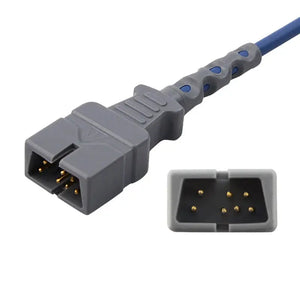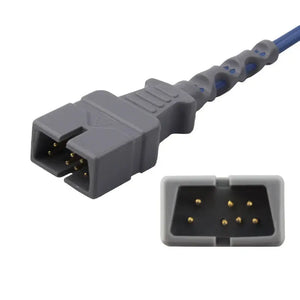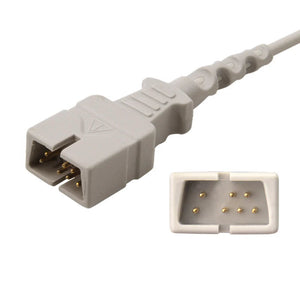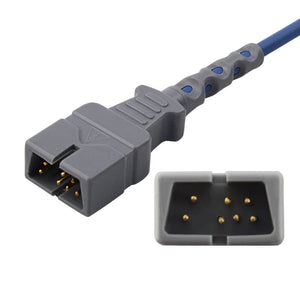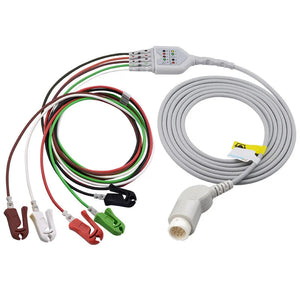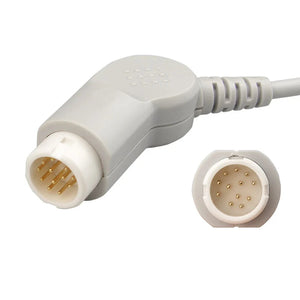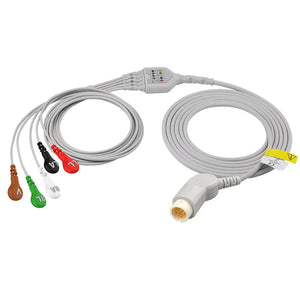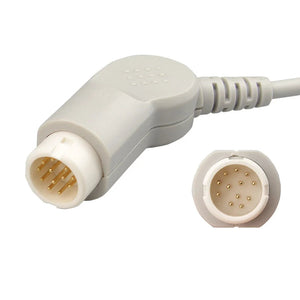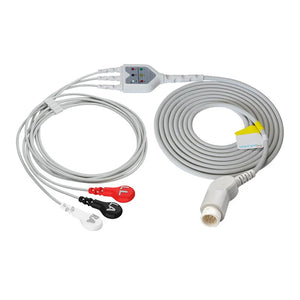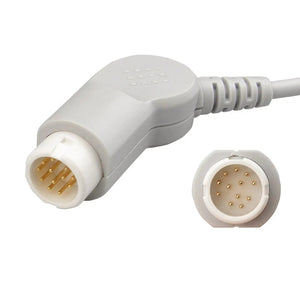You can learn how to read a hospital monitor by understanding what each number and line represents. Hospital monitors display important information such as heart rate, blood pressure, oxygen saturation, and respiratory rate. These numbers are essential for tracking your health and can help ease your mind when you know what is considered normal.
Key Takeaways
- Hospital monitors show important signs like heart rate, blood pressure, and oxygen saturation. These numbers help you know about your health.
- Normal heart rate for adults is 60 to 100 beats per minute. If your heart rate is too high or too low, tell your nurse right away.
- Blood pressure readings have two numbers: systolic and diastolic. A normal reading is about 120 over 80 mmHg. Tell someone if you see sudden changes.
- Oxygen saturation (SpO₂) shows how well your blood carries oxygen. A normal level is 95 percent or higher. Tell staff if it goes below 90 percent.
- Respiratory rate counts how many breaths you take each minute. Normal rates are different for each age. Tell your nurse if breathing is fast or slow.
- Hospital monitors use alarms to warn staff about big changes. Learn the alarm sounds and colors so you know when to get help.
- If you do not understand the monitor readings, ask your nurse to explain. Nurses are there to help you learn about your health.
- Staying calm while in the hospital can help you feel better. Ask questions and get help from your care team and family.
Understanding Vital Signs
The table below outlines the most common vital signs and waveforms
| Vital Sign/Waveform | Description | Normal Range |
|---|---|---|
| Heart Rate (HR) | Beats per minute (bpm), usually in green | 60-100 bpm |
| Blood Pressure (BP) | Systolic/Diastolic values | ~120/80 mmHg |
| Oxygen Saturation (SpO2) | Oxygen in the blood | 95% or greater |
| Respiratory Rate (RR) | Breaths per minute | 12-20 breaths per minute |
Knowing these numbers can help you feel confident when you see monitors such as MedLinket's Memorabilia, Masimo 1863, Nellcor M1192T, or Masimo 4050 in use. Understanding how to read a hospital monitor ensures you are informed and reassured about your health status.
How to Read a Hospital Monitor
Monitor Basics
What It Shows: Hospital monitors help you watch your health. Most show heart rate, blood pressure, temperature, and oxygen saturation. Some can also show carbon dioxide or invasive blood pressure. You can use these to notice changes in your body.

Main Features:
- Display size and clarity: Most screens are big and easy to see. They are usually at least 10 inches wide.
- Multiparameter monitoring: You can check many vital signs at once. These include ECG, SpO₂, and NIBP.
- Portability and mounting: You can move monitors or put them on walls.
- Alarm management: Smart alarms help stop loud noises. They warn you about real problems.
- Connectivity: Monitors can link to hospital networks and other machines
- Data storage: They save patient data for looking at trends later.
- Battery life: Monitors can run for 2–4 hours on battery if needed.
- Software upgrades: Updates help the monitor work better and add new things.
- User interface: Simple controls make it easy for you and staff to use.
- Cost and support: Good monitors have warranties and help after you buy them.
Layout & Colors
You can learn to read a hospital monitor by knowing where to look. Each number and color has a place. Most monitors use colors and clear layouts to help you find things fast. The right side of the screen shows numbers for each vital sign. The left side often shows waveforms like the ECG line.
Here is a table that shows how some key things look on the monitor
| Parameter | Display Location | Color Code |
|---|---|---|
| Heart Rate | Right corner | Green numbers |
| Respiration Rate | Displayed as 'RESP' | N/A |
| Temperature | Under 'TEMP' | N/A |
| Oxygen Saturation | N/A | N/A |
| Carbon Dioxide | N/A | N/A |
| Invasive Blood Pressure | N/A | N/A |
You will see heart rate in green at the top. This helps you notice changes fast. Numbers are big and easy to read. Waveforms show how your heart and lungs are working.
Display Features
Hospital monitors have many features to help care for patients. The alarm system tells you when something is wrong. The monitor saves data so you can see changes over time. You can connect it to other devices for better care. The controls are simple, so you can find what you need.
If you want to read a hospital monitor, start with the numbers and colors. Check the heart rate, blood pressure, temperature, and oxygen saturation. Look for green numbers at the top for heart rate. Use the waveforms to see how your heart and breathing look.
Tip: If you do not understand what you see, ask your nurse or doctor. They can tell you what the numbers mean and help you learn about your health.
ICU Monitor Parameters
ICU monitors track several key parameters to help you and your care team watch your health closely. These include heart rate, blood pressure, and oxygen saturation. You can see these numbers update every few seconds on the display. Learning how to read a hospital monitor helps you understand what these numbers mean and when to ask for help.

Heart Rate
What It Means
Heart rate tells you how many times your heart beats in one minute. This number shows how well your heart pumps blood through your body. A normal heart rate means your heart works as it should. If the number is too high or too low, it can signal a problem.
Reading the Value
You will find the heart rate at the top of the monitor, usually in green and bold. The number updates every few seconds. Some monitors also show a pulse rate (PR) in a separate box. The heart rate comes from the ECG leads attached to your chest.
Tip: If you see a sudden change in heart rate, let your nurse know right away.
Comment
byu/nuvyco from discussion
inorangetheory
Normal Ranges
Normal heart rate depends on your age. The table below shows the usual ranges for different age groups:
| Age | Normal Heart Rate (beats per minute) |
|---|---|
| 0 to 3 months | 110–160 |
| 3 to 6 months | 100–150 |
| 6 to 12 months | 90–130 |
| 1 to 3 years | 80–125 |
| 3 to 6 years | 70–115 |
| 6 to 12 years | 60–100 |
| 12 to 18 years | 60–100 |
| Adults | 60–100 |
Most adults have a heart rate between 60 and 100 beats per minute. Children and infants have higher normal rates.
When to Worry
You should worry if the heart rate goes much higher or lower than normal for your age. For adults, a heart rate below 50 or above 120 can be a sign of trouble. Fast heart rates may mean fever, pain, or heart problems. Slow rates can happen with certain medicines or heart conditions. Always tell your nurse if you see a number outside the normal range.
Modern ICU monitors, give very accurate heart rate readings. About 85% of measurements are within 3 beats per minute of your true heart rate, and 91% are within 5 beats per minute.

Blood Pressure
Systolic & Diastolic
Blood pressure shows the force of blood against your artery walls. The monitor gives two numbers: systolic (top number) and diastolic (bottom number). Systolic pressure measures the force when your heart beats. Diastolic pressure measures the force when your heart rests between beats.
Reading the Value
You will see blood pressure as two numbers, like 120/80. The first is systolic, and the second is diastolic. The monitor updates this value every few minutes. Some monitors use a cuff on your arm (non-invasive), while others use a thin tube in your artery (invasive).
| Age Group | Systolic (mm Hg) | Diastolic (mm Hg) |
|---|---|---|
| Newborns (up to 1 month) | 60–90 | 20–60 |
| Infants | 87–105 | 53–66 |
| Toddlers | 95–105 | 53–66 |
| Preschoolers | 95–110 | 56–70 |
| School-aged children | 97–112 | 57–71 |
| Adolescents | 112–128 | 66–80 |
| 18-39 Female | 110 | 68 |
| 18-39 Male | 119 | 70 |
| 40-59 Female | 122 | 74 |
| 40-59 Male | 124 | 77 |
| 60+ Female | 139 | 68 |
| 60+ Male | 133 | 69 |
Normal Ranges
Normal blood pressure depends on your age and sex. For most adults, a normal reading is around 120/80 mm Hg. Children and infants have lower normal values.
When to Worry
You should worry if your blood pressure is much higher or lower than normal. High blood pressure (hypertension) can damage your heart and kidneys. Low blood pressure (hypotension) can cause dizziness or fainting. If you see a sudden drop or rise, tell your nurse right away.
ICU monitors use special technology to keep blood pressure readings accurate. Non-invasive blood pressure (NIBP) readings are usually close to invasive readings, with a median difference of about 6 mm Hg. Some factors, like age, body mass, or certain medicines, can affect the readings.
Oxygen Saturation
What It Means
Oxygen saturation (SpO₂) shows how much oxygen your blood carries. This number tells you if your body gets enough oxygen. The monitor uses a sensor on your finger, toe, or ear to check this.
Reading the Value
You will see SpO₂ as a percentage, like 98%. The number updates every few seconds. Make sure the sensor fits snugly and your hand is warm for the best reading. If the sensor is loose or your hand is cold, the reading may not be correct.
For adults, a normal SpO₂ is 95-100%.
For children, doctors aim for at least 90%.
In most hospitals, staff try to keep SpO₂ above 92%.
Normal Ranges
Most healthy adults have an SpO₂ between 95% and 100%. Children should have at least 90%. If your number drops below these levels, your body may not get enough oxygen.
When to Worry
You should worry if your SpO₂ falls below 90%. This can mean your lungs are not working well, or you need more oxygen. If you see a sudden drop, call your nurse right away.
Many things can cause a false reading on the monitor. These include bright lights, nail polish, tattoos, cold hands, movement, or certain blood problems. Always check that the sensor is clean and fits well.
Note: If you have questions about how to read a hospital monitor or what your SpO₂ means, ask your care team.
MedLinket offers a full line of disposable SpO₂ sensors designed for clinical accuracy and patient comfort. These sensors meet strict ISO and FDA standards and use biocompatible materials to reduce skin irritation. MedLinket's sensors have a low failure rate and come in several types, such as Comfort Sponge, Elastic Non-Woven, and Transparent Ventilated, to fit different needs. They work with most major monitors and cost less than many other brands. These features make them a smart choice for hospitals in the United States. MedLinket's sensors are especially helpful for neonates and children, who need gentle and reliable monitoring.
Respiratory Rate & Temperature
Respiratory Rate
What It Means
Respiratory rate tells you how many breaths you take each minute. This number helps your care team see if your lungs and body work well together. Breathing brings oxygen in and takes carbon dioxide out of your blood.
Respiratory rate is important for getting oxygen and removing carbon dioxide.
If your breathing gets faster, it can mean low oxygen or too much acid in your blood.
If your breathing gets very slow, your body may not control breathing well, which is dangerous.
Dr. Frederic Michard says, “Respiratory rate monitoring is the best way to spot health problems early. It goes up in illnesses like sepsis, acidosis, shock, and pneumonia.”
Reading the Value
You can find your respiratory rate on the hospital monitor. It is often labeled as "RESP" or "RR." The number changes every few seconds. Some monitors show a line that moves up and down with each breath. If the number goes up or down quickly, tell your nurse.
Changes in respiratory rate are often the first sign of a serious problem.
Finding changes early can help stop problems and improve your health.
Normal Ranges
Your normal respiratory rate depends on your age. The table below shows the usual ranges
| Age Group | Normal Respiratory Rate (breaths per minute) |
|---|---|
| Adults | 12 to 20 |
| Birth to 6 months | 30 to 60 |
| 6 months to 1 year | 30 to 50 |
| 1 to 3 years | 24 to 40 |
| 3 to 5 years | 22 to 34 |
| 5 to 12 years | 16 to 30 |
| 12 to 18 years | 12 to 20 |
When to Worry
You should worry if your breathing is much faster or slower than normal for your age. Fast breathing can mean infection, pain, or lung trouble. Slow breathing can happen with some medicines or if you are very sick. Always tell your nurse if you see a big change.
Temperature
What It Means
Body temperature shows how warm your body is inside. It helps your care team check for fever or low temperature. Fever can mean infection or swelling. Low temperature can mean other health problems.
Reading the Value
You can find your temperature on the monitor, usually under "TEMP." Hospitals use different tools to check temperature. The Braun tympanic thermometer is very good, with a mean error of only 0.044 °C. Other tools, like thermal cameras, are not as good.

Normal Ranges
Normal temperature depends on your age. The tables below show the usual ranges
| Group | Normal Temperature Range |
|---|---|
| Adults | 97°F - 99°F |
| Children | 97.9°F - 100.4°F |
| Age Group | Normal Temperature Range |
|---|---|
| Birth to 10 | 95.9°F - 99.5°F |
| Ages 11 to 65 | 97.6°F - 99.6°F |
| Over 65 | 96.4°F - 98.5°F |
When to Worry
You should worry if your temperature is higher or lower than normal. High temperatures often come from infections like COVID-19, flu, or pneumonia. Bacterial infections, like sepsis or urinary tract infections, can also cause fever. Low temperatures can happen with some illnesses or after surgery. If you see a sudden change, tell your nurse right away.
Tip: Always ask your care team if you have questions about your breathing or temperature numbers. They can help you know what the numbers mean for your health.
Heart Rate & Waveforms
ECG
What It Shows
An ECG waveform shows your heart’s electrical activity. You can watch your heart beating live on the screen. The monitor has a moving line with repeating waves. Each wave is a part of your heartbeat. The ECG helps you and your care team see changes in your heart’s rhythm and rate.
You can use the ECG to:
- Look for abnormal waveforms that may mean dysrhythmias. These changes can hurt your health and may need quick help from your nurse.
- Find early warning signs. Early changes in the ECG pattern help your care team act before things get worse.
- Notice symptoms like chest pain, dizziness, or confusion. These can happen if your heart’s signals change and your heart pumps less blood.
- Spot dangerous rhythms. Some patterns, like ventricular tachycardia or ventricular fibrillation, can cause cardiac arrest and need emergency care.
Tip: If you feel dizzy or have chest pain, tell your nurse right away. The ECG can help find out why.
Normal vs. Abnormal
You can compare normal and abnormal ECG waveforms by checking certain features. The table below shows what to look for
| Feature | Normal ECG Characteristics | Abnormal ECG Characteristics |
|---|---|---|
| Heart Rate | 60-100 beats per minute | Outside the range, indicating tachycardia or bradycardia |
| Rhythm | Regular intervals between heartbeats | Irregular intervals, possible arrhythmias |
| P Wave | Smooth, rounded upward deflection before QRS complex | Notched, enlarged, or absent P waves |
| QRS Complex | Duration less than 120 milliseconds, normal voltage | Widened or fragmented, indicating conduction delays |
| T Wave | Upright orientation, proportional to QRS | Inverted, peaked, or flattened shapes |
| ST Segment | Flat and aligns with TP segment baseline | Elevation or depression, indicating potential cardiac issues |
A healthy heart shows a steady, regular pattern. If the line looks strange, or waves are missing, your heart may not be working right. Always ask your care team if you see a sudden change on the monitor.
SpO₂ Waveform
What It Shows
The SpO₂ waveform, or plethysmograph, shows how blood moves through your finger or sensor spot. This line goes up and down with each heartbeat. The shape and size of the line help your care team check your oxygen and blood flow.
You can use the SpO₂ waveform to:
- See how well your heart pumps blood. The line shows changes in your cardiovascular system and matches your oxygen saturation.
- Find early signs of trouble. In patients with sepsis, a lower or flat line can mean your health is getting worse and your heart pumps less blood.
- Check for perfusion problems. If the line looks weak or disappears, your body may not get enough blood flow, even if your oxygen number looks normal.
- Learn how oxygen is measured. The monitor checks your oxygen by comparing oxygen-rich and oxygen-poor blood. The line helps confirm the reading.
Note: A strong, regular SpO₂ line means your sensor works well and your blood flow is good. If the line is weak or missing, ask your nurse to check the sensor and your circulation.
Normal vs. Abnormal
A normal SpO₂ line looks smooth and regular, with clear peaks for each heartbeat. You should see a steady pattern that matches your pulse. An abnormal line may look flat, jagged, or disappear sometimes. This can mean poor blood flow, a loose sensor, or a serious health problem.
A good line means your reading is correct.
A bad or missing line may mean severe hypoperfusion or a sensor problem.
MedLinket’s disposable SpO₂ sensors use advanced technology for accurate and comfortable readings. Their design helps keep the probe in place and lowers skin irritation, which is important for long-term use. These sensors meet strict ISO and FDA rules, making them a trusted choice in American hospitals.
Tip: Always check both the SpO₂ number and the line. Both help you and your care team understand your oxygen status.
Temperature (TEMP)
Screen example: TEMP 98.6 °F (37.0 °C) — some monitors also show T1 / T2 and ΔT (difference).
What You’ll See
| Item | On-Screen Label | Typical Unit | Notes |
|---|---|---|---|
| Temperature | TEMP / T1 / T2 | °F (and/or °C) | May show site (esophageal, bladder, rectal, skin) |
| Delta | ΔT | °F / °C | Difference between T1 and T2 |
| Trend | Graph | — | 24-hr or session trend line |
How to Read
- Confirm unit (°F vs. °C)
- If two channels exist (T1/T2), check ΔT and trend, not just a single point.
- Interpret alongside symptoms (chills, confusion) and meds (antipyretics).
Normal vs. Abnormal (Adults, reference)
| Status | °F | °C |
|---|---|---|
| Typical | 97.0–99.0 | 36.1–37.2 |
| Fever | ≥100.4 | ≥38.0 |
| Hypothermia | <95.0 | <35.0 |
When to Worry
- Fever ≥102.2 °F (39.0 °C), fever with rash or confusion, or fever plus low blood pressure.
- Post-operative low temperature not improving.
Factors That Skew Readings
- Measurement site, poor probe contact, warming blankets/fluids, room temperature, drinks/ice chips, heavy sweating, antipyretics.
Quick Tip: Trends beat single numbers. Ask staff to confirm with a clinical thermometer if unsure.
Carbon Dioxide / Capnography (EtCO₂)
Screen example: EtCO₂ 38 mmHg with a square-topped (rounded rectangle) capnogram; often paired with RR 16.
What You’ll See
| Item | On-Screen Label | Typical Unit | Notes |
|---|---|---|---|
| End-tidal CO₂ | EtCO₂ | mmHg (or kPa) | Numeric value |
| Respiratory Rate | RR / RESP | breaths/min | Derived from capnogram |
| Capnogram | CO₂ waveform | — | Four phases; alveolar plateau is key |
How to Read
- Check EtCO₂ number (typical adult target 35–45 mmHg).
- Inspect waveform shape (flat plateau, sharp inspiratory downstroke).
- Read together with RR, SpO₂, and patient condition.
Normal vs. Abnormal (Adults)
| Finding | Possible Causes |
|---|---|
| 35–45 mmHg (normal) | Adequate ventilation/perfusion |
| <35 mmHg | Hyperventilation, low cardiac output, sampling leak |
| >45 mmHg | Hypoventilation, airway obstruction, rebreathing, increased CO₂ production |
When to Worry
- Sudden drop toward 0 → possible disconnection/extubation/cardiac arrest (get help).
- Shark-fin waveform → bronchospasm/obstruction.
- New notch on the plateau → patient effort/asynchrony on the ventilator.
Factors That Skew Readings
- Loose cannula, high O₂ flow diluting sample, condensation/secretions in tubing, very low tidal volumes, talking/movement.
Quick Tip: Always interpret number + waveform + trend together.
Invasive Blood Pressure (IBP)
Screen example: ART 122/68 (MAP 89) mmHg with a dicrotic notch on the arterial waveform. Other channels may show CVP 8 mmHg, PAP 25/10 (15).
What You’ll See
| Channel | Label | Values | Waveform Clues |
|---|---|---|---|
| Arterial | ART | Sys/Dia + MAP | Fast upstroke + dicrotic notch |
| Central Venous | CVP | Mean (mmHg) | Low-amplitude venous waves |
| Pulmonary Artery | PAP | Sys/Dia + mean | Distinct PA morphology |
How to Read
- Verify channel (ART vs. CVP vs. PAP).
- Focus on MAP for perfusion (many adult targets ≥65 mmHg per orders).
- Check waveform quality (over-/under-damping, correct zero/level).
Normal vs. Abnormal (Common Adult References)
| Measure | Typical Reference |
|---|---|
| ART | ~120/80 mmHg (MAP ~70–100) |
| CVP | 2–8 mmHg |
| PAP | ~15–30/8–15 mmHg (mean 10–20) |
Targets vary by condition (sepsis, pregnancy, neuro). Follow care-team goals.
When to Worry
- MAP falls quickly or pulse pressure collapses (bleeding, pump failure, line issue).
- Blunted waveform/no notch → over-damping (air/clot/filter).
- Ringing/overshoot → under-damping (false high).
- Transducer not leveled to phlebostatic axis or not zeroed.
Factors That Skew Readings
- Bad zero/level, air bubbles, long/looped tubing, low flush pressure, patient position changes, arrhythmias.
Quick Tip: If numbers look odd, verify the waveform and setup, then cross-check with cuff NIBP and clinical signs.

Non-Invasive Blood Pressure (NIBP)
Screen example: NIBP 118/76 (MAP 90) mmHg with auto-cycle interval (e.g., every 5 min) and cuff status.
What You’ll See
| Item | On-Screen Label | Notes |
|---|---|---|
| Systolic/Diastolic/MAP | NIBP | Single reading or auto-cycled |
| Interval | qX min | Next measurement countdown |
| Status | Cuff icon/message | Fit/placement prompts |
How to Read
- Use the right cuff size and place at heart level (brachial artery marker aligned).
- Watch trends and repeat if the number doesn’t match how the patient feels.
- Compare with other indicators (pulse, cap refill, mentation).
Normal vs. Abnormal (Adults, reference)
| Status | Guidance |
|---|---|
| Typical ~120/80 mmHg | MAP ~70–100 |
| Hypertension (varies by guideline) | ≥130/80 mmHg |
| Hypotension | Systolic <90 mmHg or MAP <65 mmHg, especially with symptoms |
When to Worry
- Rapid swings from baseline, or >10–15 mmHg gap vs. IBP after confirming technique.
- “Normal” cuff reading but the patient appears unwell—recheck, try the other arm, escalate.
Factors That Skew Readings
- Wrong cuff size (too small → false high; too large → false low), arm not at heart level, movement/talking, arrhythmias, cold/painful limb, too-frequent cycling.
Quick Tip: Re-measure after 1–2 minutes with correct positioning; compare against symptoms and trends.
One-Look Pocket Summary (U.S.)
| Parameter | Quick Range | Red Flags |
|---|---|---|
| TEMP | 97.0–99.0 °F typical | ≥100.4 °F fever; <95.0 °F hypothermia |
| EtCO₂ | 35–45 mmHg | Sudden ~0 (disconnect/arrest); shark-fin (obstruction) |
| IBP (ART) | ~120/80; focus on MAP ≥65 (per orders) | Rapid MAP drop; waveform damping/zero-level errors |
| NIBP | ~120/80; MAP ~70–100 | Big swings or mismatch with symptoms/IBP |
If you see a red alarm or numbers far from the patient’s usual pattern, tell the nurse immediately. When in doubt, ask the care team to walk you through your unit’s specific targets and screen layout.
Alarms & Alerts
Hospital monitors use alarms and alerts to keep you safe. These alarms help you and your care team notice changes in your health right away. You will hear different sounds and see different colors on the monitor. Each one has a special meaning.
Types of Alarms
You will notice several types of alarms on hospital monitors. Each type helps you understand what is happening with your body or the equipment.
- Life-threatening alarms: These alarms warn you about critical problems that could cause severe harm or even death. They often sound loud and urgent, with red lights or flashing symbols.
- Imminent danger alarms: These alarms alert you to changes that may become dangerous soon. You might hear a fast beeping sound and see yellow or orange lights.
- Diagnostic alarms: These alarms tell you about specific medical conditions, not just numbers out of range. The monitor may show a message or symbol to explain the issue.
- Device malfunction alarms: These alarms warn you if the monitor or another device is not working right. You may hear a steady tone and see a blue or white light.
- Imminent device malfunction alarms: These alarms give you an early warning that a device might fail soon. The sound is usually softer, and the light may blink slowly.
Tip: Red alarms mean you should get help right away. Yellow or orange alarms mean you should pay attention and tell your nurse.
Common Causes
Not every alarm means there is a real problem. Sometimes, alarms go off by mistake. These are called false alarms. The table below shows some common causes
| Cause of False Alarms | Description |
|---|---|
| Low-voltage QRS complexes | The monitor may misread your heart rhythm, causing a false alarm for no heartbeat. |
| Default alarm settings | Monitors often use very sensitive settings, which can lead to more false alarms. |
| Patient movement or repositioning | Moving in bed or adjusting sensors can trigger alarms, even if you are healthy. |
| Excessive number of alarms | Too many alarms can make it hard for staff to notice real problems. |
| High percentage of false arrhythmia alarms | Most arrhythmia alarms are not true emergencies, which can cause confusion. |
You can help reduce false alarms by staying still during measurements and making sure sensors fit well.
What to Do
When you hear an alarm, you might feel worried. You can take simple steps to stay calm and help your care team.
- Listen to the alarm and look at the monitor. Try to notice the color and sound.
- Stay calm. Not every alarm means an emergency.
- Call your nurse or care team if you see a red alarm, a sudden change in numbers, or if you feel unwell.
- Ask your nurse about the alarm settings. You can learn why alarms sound and what they mean for your care.
- Share any concerns you have about alarms. Your feedback helps staff adjust settings and keep you safe.
Note: Alarms are there to protect you. If you do not understand an alarm, always ask your nurse or doctor. They want you to feel safe and informed.
By learning about alarms and alerts, you can feel more confident during your hospital stay. You will know when to ask for help and how to work with your care team to stay safe.
Tips for Patients & Families
When to Ask for Help
It is normal to feel unsure when you look at hospital monitors. If you see numbers that are not in the normal range or if alarms go off, call your nurse. Trust how you feel. If you notice a quick change in heart rate, blood pressure, or oxygen levels, ask for help right away. Tell someone if you feel dizzy, have trouble breathing, or feel chest pain. These signs can mean something is wrong, even if the monitor looks okay.
Tip: Always ask questions if you are confused. Your care team wants you to feel safe and know what is happening.
Talking to Staff
Talking well with hospital staff helps you understand your care better. Try these ideas to make your talks easier:
-
Build Trust: Sit down with staff when you talk. This helps you feel more relaxed and builds trust.
-
Ask Open-Ended Questions: Use questions like “Can you explain what this number means?” or “How does this affect my health?” This helps you get clear answers.
-
Use Plain Language: Ask staff to use simple words instead of medical ones you do not know. This makes things easier to understand.
-
Ensure Confidentiality: You can ask for a private talk if you want to discuss something personal.
-
Culturally Competent Communication: If you do not speak English well, ask for an interpreter. Staff can help you feel heard and respected.
You help your care team by sharing your worries and asking them to explain things. Working together leads to better care and less worry.
Staying Calm
Knowing what you see on the monitor can help you stay calm. When you understand the numbers, you feel more in control. Studies show that family support and clear information can lower heart rate and blood pressure. The table below shows how family visits and knowing about monitors can help
| Study | Findings |
| Effect of protocol-based family visitation on physiological indicators in ICU patients | Decrease in heart rate observed in intervention group, suggesting calming effect. |
| Jani (2015) | Supportive family caregiving modulated physiological parameters in spinal cord injury patients. |
| Rahmani’s study | Structured visitations led to modulation of systolic blood pressure by the third day. |
| Akbari et al. (2019) | Reduction in systolic blood pressure observed 30 minutes post-visit. |
| Salavati et al. (2012) | No significant changes noted, indicating individual variability. |
You can remember these facts to help you feel better. If you get nervous, take slow breaths and think about what you know. Ask your nurse to explain anything that makes you worry. Staying calm helps you and your family during a hospital stay.
Note: You are a key part of the care team. Your questions and support help make the hospital safer and more comfortable.
When you know how to read hospital monitor numbers, you feel calmer. Normal ranges are just a guide, not a rule. Your care team can answer questions or explain changes. Use what you learned to feel sure about your health. If you do not understand something, ask the staff for help.
FAQ
What should I do if I see a number outside the normal range?
You should call your nurse or doctor right away. Numbers outside the normal range can mean your body needs help. Trust your feelings and ask questions if you feel worried or notice sudden changes.
Why does the monitor alarm keep sounding?
Monitors sound alarms for many reasons. Sometimes, you move or a sensor slips. Other times, your numbers change. Always check with your nurse if you hear an alarm or feel unsure.
How do MedLinket’s disposable SpO₂ sensors help patients?
MedLinket’s disposable SpO₂ sensors give accurate oxygen readings. They use soft materials and special designs for comfort. These sensors fit many monitors and meet strict safety rules, making them a smart choice for hospitals in the United States.
What makes MedLinket’s SpO₂ sensors different from others?
MedLinket’s sensors use a three-point positioning system for better fit and comfort. They pass FDA and ISO tests and have a failure rate below 1%. You can use them with many brands, and they cost less than some other top brands.
Are there different types of SpO₂ sensors for different patients?
Yes. MedLinket offers Comfort Sponge for long-term use, Elastic Non-Woven for short-term or active patients, and Transparent Ventilated for better airflow. Each type helps meet the needs of babies, children, and adults.
What should I do if the SpO₂ sensor keeps falling off?
Tell your nurse if the sensor slips or feels loose. MedLinket’s sensors use special adhesives and designs to stay in place, even if you move. Your care team can help adjust or replace the sensor for better results.
How do I stay calm when watching the monitor?
Take slow breaths and remember that alarms help keep you safe. Ask your nurse to explain what you see. Knowing what the numbers mean can help you feel more in control and less anxious.



